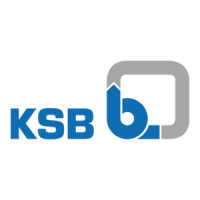5 Installation/Dismantling
14 of 44
4STQ
2580.821/04-EN
5 Installation/Dismantling
NOTE
Priority shall be given to the installation instructions and/or installation sequence in
the documents of the pump set into which this mechanical seal is to be installed.
This also applies to the dismantling instructions and/or dismantling sequence.
5.1 Permissible aids
CAUTION
Impermissible cleaning agents
Damage to the seal faces at the mechanical seal!
▷ For removing minor contamination use only paper tissues and ethyl alcohol.
▷ Do not use dirty cleaning cloths or cleaning cloths that leave behind lint.
CAUTION
Impermissible assembly aids
Sealing elements made of ethylene propylene diene rubber perishing or swelling
up!
▷ Never let sealing elements come into contact with mineral oil base lubricants.
▷ Use permissible lubricants only.
▷ Verify that the assembly aids are silicon-free.
▪ Lubricants
2)
– Permanent lubricants, such as non-mineral grease (Klüber AsonicHQ72-102)
are used for elastomers that do not serve to transmit the torque. Examples
are mating rings with an anti-twist lock or primary rings that move axially
relative to the pump components.
– Non-permanent lubricants such as a soap solution, for example, are used for
elastomers that serve as a sealing element and, in addition, transmit the
torque. An example would be a mating ring without anti-twist lock.
▪ Recommended cleaning agent for seal faces and grub screws: ethyl alcohol
▪ Thread-locking agent: Loctite, No. 243
▪ Open-ended wrench, ring spanner, socket wrench (cleaned, no impact tools)
▪ Torque wrench (cleaned)
5.2 Prerequisites
▪ Shaft run-out to ISO5199:
– For shaft diameter ≤50mm: 0.05mm max.
– For shaft diameter 50 to 100mm: 0.08mm max.
– For shaft diameter >100mm: 0.10mm max.
▪ Face run-out of the shaft in relation to the vertical connection surface of the
casing:
– For shaft speed ≤750rpm: 0.2mm max.
– For shaft speed >750rpm to 1000rpm: 0.15mm max.
– For shaft speed >1000rpm to 1500rpm: 0.08mm max.
– For shaft speed >1500rpm to 3000rpm: 0.025mm max.
▪ The seal faces are clean and have not been touched with fingers.
2) Lubricants must be compatible with all fluids used. They must not be aggressive to the secondary sealing elements.

